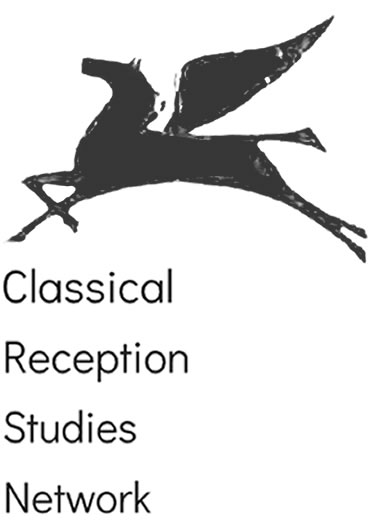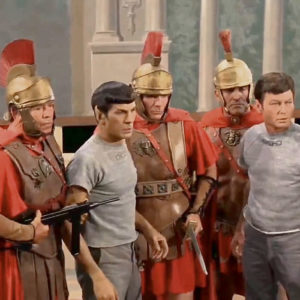Star Trek exists as what Daniel Bernardi calls a ‘mega-text’, a group of televisual, filmic, literary, auditory, and other ‘texts’ that all share a relatively cohesive fictional universe. The amount of ‘texts’ that make up the Star Trek franchise includes hundreds of hours of television and films, hundreds of books and audio books, and numerous video games. It spans over fifty years, from the first television episode in 1966 to the latest novel published in February 2017. Not only is this ‘mega-text’ similar to Classical mythology – which also uses the same characters and stories told by different authors across different media – it also includes a number of classical references itself.
The franchise therefore provides us with a unique opportunity to examine classical reception in science-fiction through semantically connected texts and over a significant time period. Not only can we see how approaches to the classical world change over time, we can also see how the audience response to them has altered. While some receptions will be rooted in their historical contexts, others may morph over Star Trek’s long fifty-year history.
 One particular example allows us to examine this in more detail. The Original Series was created by Gene Roddenberry and hit the air in September of 1966. For Roddenberry, the series was intended as a sort of Gulliver’s travels in space, incorporating various stories layered with social commentary on matters such as Vietnam, racism, and the occasional ecological issue. But on the Ides of March, 1968, Roddenberry turned his science-fiction lens directly on the Romans with the episode ‘Bread and Circuses’. The episode sees Captain Kirk and crew attempt a rescue mission from a world that is the mirror of Roman society, yet in which the empire never fell. Instead, they have reached the technological sophistication of the Sixties. Kirk and crew befriend some escaped slaves, known as the ‘Children of the Sun’, before being forced to fight in televised gladiatorial games by the evil Proconsul. They manage to escape this new Rome, however, and return to their ship. Once there, they discover that the ‘Children of the Sun’ were in fact the ‘Children of the Son’, i.e. the Son of God. Captain Kirk marvels at what it would be like to watch Christianity replace the Roman empire all over again.
One particular example allows us to examine this in more detail. The Original Series was created by Gene Roddenberry and hit the air in September of 1966. For Roddenberry, the series was intended as a sort of Gulliver’s travels in space, incorporating various stories layered with social commentary on matters such as Vietnam, racism, and the occasional ecological issue. But on the Ides of March, 1968, Roddenberry turned his science-fiction lens directly on the Romans with the episode ‘Bread and Circuses’. The episode sees Captain Kirk and crew attempt a rescue mission from a world that is the mirror of Roman society, yet in which the empire never fell. Instead, they have reached the technological sophistication of the Sixties. Kirk and crew befriend some escaped slaves, known as the ‘Children of the Sun’, before being forced to fight in televised gladiatorial games by the evil Proconsul. They manage to escape this new Rome, however, and return to their ship. Once there, they discover that the ‘Children of the Sun’ were in fact the ‘Children of the Son’, i.e. the Son of God. Captain Kirk marvels at what it would be like to watch Christianity replace the Roman empire all over again.
 The episode draws on Hollywood’s Roman epics for its visual cues in depicting a modern Roman empire, coupling gladiators with sports magazines, for example. As for the social commentary, it comes mostly through the episode’s title, which is drawn from Juvenal’s tenth satire (10.77-81) in which he decries the de-politicisation of the Roman populace in favour of ‘bread and circuses’. In the episode, the ‘circus’ is television. The episode is littered with satire on the television industry, comparing this growing medium with the gladiatorial games in Rome. Essentially, the episode is telling its audience that by watching, they are becoming Juvenal’s de-politicised populace.
The episode draws on Hollywood’s Roman epics for its visual cues in depicting a modern Roman empire, coupling gladiators with sports magazines, for example. As for the social commentary, it comes mostly through the episode’s title, which is drawn from Juvenal’s tenth satire (10.77-81) in which he decries the de-politicisation of the Roman populace in favour of ‘bread and circuses’. In the episode, the ‘circus’ is television. The episode is littered with satire on the television industry, comparing this growing medium with the gladiatorial games in Rome. Essentially, the episode is telling its audience that by watching, they are becoming Juvenal’s de-politicised populace.
 The episode has other satirical targets, too. Not only does it visually mirror the Roman epic films of the fifties and sixties, such as Quo Vadis (1953) and Spartacus (1960), it also mirrors them on the narrative level. The story of a group of downtrodden Christians fighting against an evil Roman, forced to fight in the arena, sounds like it could have been lifted directly from many of those movies. Through this comparison, the episode broadens its satire to include cinema, adding these epics to Juvenal’s new ‘circuses’.
The episode has other satirical targets, too. Not only does it visually mirror the Roman epic films of the fifties and sixties, such as Quo Vadis (1953) and Spartacus (1960), it also mirrors them on the narrative level. The story of a group of downtrodden Christians fighting against an evil Roman, forced to fight in the arena, sounds like it could have been lifted directly from many of those movies. Through this comparison, the episode broadens its satire to include cinema, adding these epics to Juvenal’s new ‘circuses’.
Then, through its science-fiction setting, the episode shows us a Rome that looks like Sixties America (with television, magazines, cars, etc.) and uses this ‘America as Rome’ metaphor to tackle contemporary issues. Through the ‘directive of non-interference’, it draws attention to the comparison between the standard imperialist metaphor of Rome and the US’s interventionist policy during the Sixties. Through its Christian message of ‘love and brotherhood’ it reflects the growing hippy culture in America, whose ‘Summer of Love’ happened just as this episode was being written.
Yet a memo from Roddenberry in Marc Cushman’s These are the Voyages (2014) shows that one of Roddenberry’s central messages was to demonstrate the similarities between the conditions of the American working class and ancient slavery. It was certainly an issue that resonated at the time, as Martin Luther King was striving forward with the ‘Poor People’s Campaign’ just as this episode aired. In ‘Bread and Circuses’ we see a kind of ‘slavery with benefits’, as these Roman slaves were granted old-age pensions and medical payments. Roddenberry sums up the comparison best in this quote:
“What a terrible thought, i.e., that I have a slave and instead of feeding her I give her money to go out and feed herself, and probably not as well as I’d feed and clothe her if she lived more closely with the family.” (Cushman, 2014: 332).
Even though this original Star Trek series was broadcast nearly fifty years ago, it still provokes much discussion. Available on DVD, Blu-ray, and now to stream on Netflix and CBS All-access, it continues to attract audiences who constantly re-examine the episodes, making podcasts about them, talking about them in discussion forums, and even writing their own blogs. ‘Bread and Circuses’ in particular has prompted blogs about the episode’s Christian message or its satirical elements, which seem to resonate even more in the present day.
That’s one of the most interesting aspects of studying the Star Trek‘s reception of the Classical world. Since all the series, films, and books are constantly being re-watched and re-examined by their audience, in new contemporary contexts, the nature of the reception is also constantly shifting. The audience is continuously making new and different connections to the ancient world through Star Trek, which is why the final frontier provides an excellent canvas on which to explore the changing nature of classical reception.
Dr Ben Greet is an Early Career Researcher currently based in Leeds. He works on the reception of Classics in Star Trek as well as the symbolism of the eagle in Roman culture. He posts on classical reception topics at www.breadandcircusesreview.wordpress.com and can be followed on Twitter @B_Greet.

